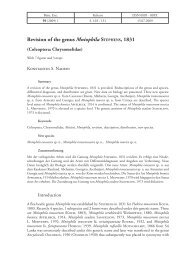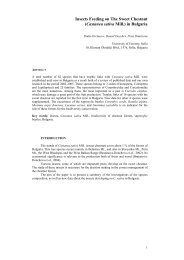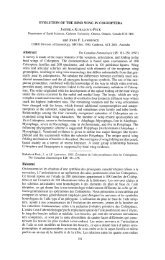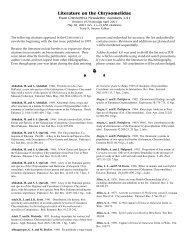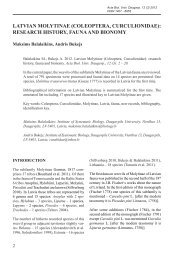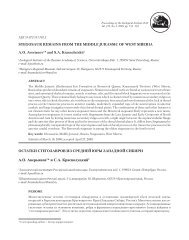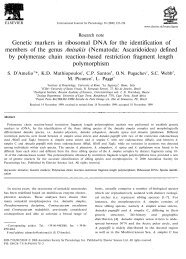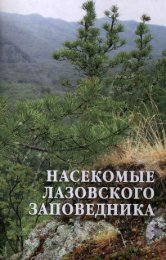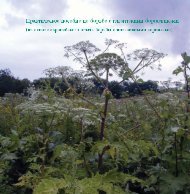International Meeting on Biology and Systematics of Staphylinidae
International Meeting on Biology and Systematics of Staphylinidae
International Meeting on Biology and Systematics of Staphylinidae
Create successful ePaper yourself
Turn your PDF publications into a flip-book with our unique Google optimized e-Paper software.
22nd <str<strong>on</strong>g>Internati<strong>on</strong>al</str<strong>on</strong>g> <str<strong>on</strong>g>Meeting</str<strong>on</strong>g> <strong>on</strong> <strong>Biology</strong> <strong>and</strong> <strong>Systematics</strong> <strong>of</strong> <strong>Staphylinidae</strong> 2007 – abstracts<br />
From KhD Mts. we know 27 species, seven <strong>of</strong> these have Holarctic distributi<strong>on</strong>al patterns,<br />
3 are Palaearctic, 9 European Siberian, 8 East Palaearctic (3 widely distributed in the<br />
East Palaearctic regi<strong>on</strong>, 1 in the Baikal regi<strong>on</strong>, 1 in KhD <strong>and</strong> ES Mts., 3 KhD endemics). For<br />
ES 20 species are known: 10 Holarctic, 1 Palaearctic, 4 – European Siberian, 5 East Palaearctic<br />
(3 widely distributed in the East Palaearctic, 1 in KhD <strong>and</strong> ES Mts., 1 ES endemic). At<br />
present time, for high altitudes <strong>of</strong> KhD Mts. 3 endemic species are known: Lesteva dabanensis<br />
Shavrin et al., L. czerskyi Shavrin, Boreaphilus komsomolkae Shavrin et al. <strong>and</strong> for ES<br />
Lesteva brathinoides Zerche. Coryphium nataliae Shavrin is a comm<strong>on</strong> endemic for KhD <strong>and</strong><br />
ES Mts. A large number <strong>of</strong> new taxa from the alpine z<strong>on</strong>e <strong>of</strong> south Siberia may be discovered<br />
in the future, especially Coryphiini, Lesteva <strong>and</strong> Eusphalerum.<br />
The inhabitants <strong>of</strong> the alpine z<strong>on</strong>e are organised into three groups <strong>on</strong> the basis <strong>of</strong> their<br />
c<strong>on</strong>necti<strong>on</strong>s with this z<strong>on</strong>e:<br />
1. Eualpine species, living in alpine tundra under st<strong>on</strong>es, near snowpatches, mountain<br />
streams <strong>and</strong> in wet mosses;<br />
2. M<strong>on</strong>tane species, found in the forest z<strong>on</strong>e, but extending into the alpine z<strong>on</strong>e (species<br />
inhabiting litter, floricolous species);<br />
3. Polyz<strong>on</strong>al species, occasi<strong>on</strong>ally col<strong>on</strong>izing biotopes <strong>of</strong> the alpine z<strong>on</strong>e (species c<strong>on</strong>nected<br />
with rotting organic material, such as Omalium; xylophilous <strong>and</strong> mycetophilous species).<br />
Towards new classificati<strong>on</strong> <strong>of</strong> the tribe Staphylinini (<strong>Staphylinidae</strong>:<br />
Staphylininae)<br />
A.Y. SOLODOVNIKOV<br />
Natural History Museum <strong>of</strong> Denmark, Copenhagen<br />
e-mail: asolodovnikov@snm.ku.dk<br />
The tribe Staphylinini which includes 211 described genera, <strong>and</strong> more than 5,300 described<br />
species, is obviously m<strong>on</strong>ophyletic, worldwide distributed <strong>and</strong> very diverse group <strong>of</strong><br />
rove beetles. It is important to have a phylogeny-based system for any reference <strong>and</strong> further<br />
study <strong>of</strong> the so large group <strong>of</strong> organisms. However, no special broad project focused <strong>on</strong> the<br />
phylogeny <strong>of</strong> Staphylinini has ever been undertaken.<br />
The existing classificati<strong>on</strong> <strong>of</strong> the tribe is largely c<strong>on</strong>venti<strong>on</strong>al <strong>and</strong> c<strong>on</strong>sists <strong>of</strong> nine<br />
vaguely delimited subtribes with unknown interrelati<strong>on</strong>ships. Preliminary large-scale phylogenetic<br />
analysis, based <strong>on</strong> the morphology <strong>of</strong> adults, c<strong>on</strong>ducted for the first time for the<br />
tribe, does not support this classificati<strong>on</strong>. It defines a new evoluti<strong>on</strong>ary pattern for the tribe,<br />
which seems to be c<strong>on</strong>sistent with the very fragmentary fossil record <strong>and</strong> current distributi<strong>on</strong><br />
pattern <strong>of</strong> Staphylinini.<br />
The newly presented phylogenteic hypothesis helps to plan a larger study which would<br />
be based <strong>on</strong> the even broader tax<strong>on</strong> sample <strong>and</strong> a combinati<strong>on</strong> <strong>of</strong> adult <strong>and</strong> larval morphological,<br />
as well as molecular characters.<br />
__________________________________________________________________________________________<br />
Staatliches Museum für Naturkunde Stuttgart 17




